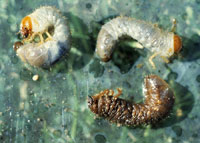Knowledgebase
Japanese Beetles #282128
Asked October 02, 2015, 12:38 PM EDT
Thank you!
Denver County Colorado
Expert Response
Hi there,
Here is some info from the following fact sheet that helps with control of Japanese Beetle while they are grubs in the soil:
http://extension.colostate.edu/topic-areas/insects/japanese-beetle-5-601/
Control of Japanese Beetle Grubs in Lawns
Japanese beetle grubs can damage turfgrass in the same manner as other turfgrass white grubs. (See CSU Extension fact sheet 5.516, Billbugs and White Grubs). Some cultural practices can limit damage and applied chemical or biological controls may also be useful. However, control of Japanese beetle larvae in a yard will have very little, if any, effect on the number of Japanese beetle adults feeding on trees, shrubs and garden plants. The insect is highly mobile so that problems with adult beetles typically involve insects that have moved a considerable distance.
Where practical, limiting water during the period when eggs are being laid and early stage larvae are present (Late June-July) can be useful in Japanese beetle control. Egg laying will be concentrated in sites where soil moisture is highest and turf growth most lush. Such favorable conditions also favor subsequent survival of eggs and larvae. Intermittent periods of slight soil drying during the late June-July period can cause adults to seek other sites for egg laying and kill many developing eggs and larvae that are present. Such manipulation of soil moisture brings with it the risk of drought stress to plants, but deep and infrequent watering practices earlier in the season promote deep rooting that can provide turfgrass much greater tolerance to brief drying periods later in the season. (For more information see CSU Extension fact sheet 7.199, Watering Established Lawns.)
Conversely, in late summer when late stage larvae are present and most actively feeding watering can help turf areas better tolerate the effects of root injuries.
Several insecticides are presently available that can provide excellent control of Japanese beetle grubs in lawns. Most commonly available are imidacloprid (Merit, Zenith, myriad other products) and chlothianidin (Arena), which are used in preventive applications as beetles prior to egg hatch. More recently available as an option is chlorantraniprole (Acelypryn, Scott’s Grub-Ex), a reduced risk insecticide that can provide excellent control of Japanese beetle larvae. These insecticides can provide control of Japanese beetle larvae over an extended period (several weeks-months) and are particularly effective against early stage larvae. Consequently applications are best made to coincide with the onset of Japanese beetle egg laying, typically in late June and early July. Rates of use are dependent on time of application with lower rates being adequate when applied against younger larvae in early summer. Higher rates are needed when late stage larvae are present. Control will diminish if applications are made later in the season, when grubs are large, and these products will often give disappointing results when used in “rescue” treatments for existing infestations in advanced stages.
(Both imidacloprid and chlothianidin are neonicotinoid insecticides that can move systemically in plants. Therefore, the use of these products is discouraged in turfgrass areas where white clover, dandelions and other flowering plants that are visited by pollinating insects are present. Spray applications of any insecticide applied to lawns should never be made so that they cover flowers and turfgrass with flowering weeds should be mowed to remove any flowers immediately prior to applications. Chlorantraniliprole [Acelypryn, Scott’s Grub-Ex], a newly registered insecticide, has considerably lower potential hazard to pollinators than do other insecticides used for control of larval Japanese beetles.).

Figure 7. A white grub (lower right) that has been infected and killed by the insect parasitic nematode Heterorhabitis sp. Insects infected by this nematode turn a reddish-brown color.
A biological control alternative for control of Japanese beetle larvae is the use of soil applications of certain insect parasitic nematodes. (These organisms are discussed in more detail in CSU Extension fact sheet 5.573, Insect Parasitic Nematodes.) Specifically effective are certain nematodes in the genus Heterorhabditis (e.g., Heterorhabditis bacteriophora, H. megadis) and several biological control suppliers will provide these organisms (Figure 7). (A list of biological control suppliers can be found on the Insect Information website at:http://bspm.agsci.colostate.edu/outreach-button/insect-information/.) Applications of Heterorhabditis nematodes are made as a soil drench, preferably during cool, overcast periods, and must be immediately watered into the turfgrass. They should be applied when Japanese beetle larvae are present and active.
Another biological control that has received considerable past attention for Japanese beetle control is milky spore (Bacillus popilliae), a bacterium that produces ‘milky disease’ in Japanese beetle grubs. (The currently available formulation is sold under the trade name St. Gabriels’ Organics Milky Spore Powder.) Milky spore powder is applied to turfgrass areas where Japanese beetle grubs are active and may infect some of the grubs, producing a chronic infection that reduces survival and reproduction. Applications of milky spore powder will not produce immediate reductions in number of Japanese beetles; successful establishment of milky spore at a site, and its subsequent natural spread, may somewhat reduce overall numbers of Japanese beetles in future years.
I hope this helps.

